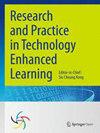教育聊天机器人的反馈如何影响人类的注意力?
IF 3
Q1 EDUCATION & EDUCATIONAL RESEARCH
Research and Practice in Technology Enhanced Learning
Pub Date : 2023-05-24
DOI:10.58459/rptel.2024.19007
引用次数: 0
摘要
教育聊天机器人已被证明在计算机支持的学习环境中是有用的助手。然而,教育聊天机器人的反馈如何影响学习者的注意力?因此,本文提出了一项研究,通过使用旨在提高人类推理能力的教育聊天机器人Liza来测量人类在学习时注意力的变化。总共有18名参与者参与了这项研究,并与Liza进行了交谈。在与Liza的互动过程中,研究参与者的注意力使用移动脑电图(EEG)设备进行测量。根据统计方法确定了三个发现。首先,研究发现,在教育聊天机器人显示反馈后,在54%的情况下出现了显著的注意力效应,并且注意力测量发生在任务的整个过程中。其次,在区分反馈类型时,137例中,正反馈有71例(51.82%)具有显著效果,负反馈有66例(48.18%)具有显著效果。第三,统计结果显示,在收到正反馈前10秒和收到正反馈后10秒,两组学生的注意力在0.05的显著水平上无显著差异。负面反馈也是如此。本文章由计算机程序翻译,如有差异,请以英文原文为准。
How can an educational chatbot's feedback influence human attention?
Educational chatbots have been shown to be useful assistants in computer-supported learning settings. However, how does feedback of an educational chatbot impact on the learner’s attention? Thus, this paper proposes a study to measure changes in human attention when learning by using an educational chatbot Liza that is intended to improve human reasoning ability. In total, 18 participants participated in the study and had a conversation with Liza. During the interaction with Liza, the attention of the study participants was measured using a mobile electroencephalogram (EEG) device. Three findings have been determined based on statistics methods. First, it was found that there was a significant attention effect occurring in 54% of the times, after the educational chatbot showed feedback and the attention measurement took place over the length of a task. Second, when differentiating the type of feedback, positive feedback had a significant effect in 71 of these 137 cases (51.82%) and negative feedback had a significant effect in 66 of the 137 cases (48.18%). Third, statistical results showed that there was no significant difference in attention at the significant level of 0.05 during the 10 seconds before, and 10 seconds after positive feedback is received. Similar is the case for negative feedback.
求助全文
通过发布文献求助,成功后即可免费获取论文全文。
去求助
来源期刊

Research and Practice in Technology Enhanced Learning
Social Sciences-Education
CiteScore
7.10
自引率
3.10%
发文量
28
审稿时长
13 weeks
 求助内容:
求助内容: 应助结果提醒方式:
应助结果提醒方式:


